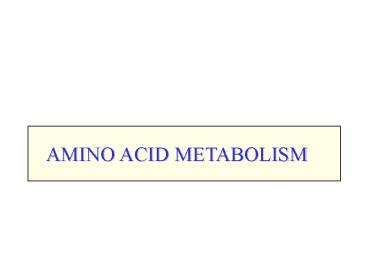AMINO ACID METABOLISM - PowerPoint PPT Presentation
1 / 23
Title:
AMINO ACID METABOLISM
Description:
Cofactor. A small ion or molecule that is required for the. enzyme to function. The cofactor often brings about a necessary 'allosteric' change in the enzyme when ... – PowerPoint PPT presentation
Number of Views:43
Avg rating:3.0/5.0
Title: AMINO ACID METABOLISM
1
AMINO ACID METABOLISM
2
AMINO ACID METABOLISM
WHAT A PLANT CAN DO TO AMINO ACIDS
1
2
oxidative deamination decarboxylation
oxidative deamination
O -NH3 -CO2
O -NH3
deamination
decarboxylation
-NH3
-CO2
3
4
Processes 1 2 3 use PLP, pyridoxyl-5-phosph
ate (B6) coenzyme Process 4 uses FAD,
flavine adenine dinucleotide (B2) coenzyme
and the coenzyme NADH (both
discussed later)
3
COENZYMES NATURES CHEMICAL
REAGENTS
4
CRUDE MODEL OF AN ENZYME-MEDIATED REACTION
The cofactor may cause an allosteric change
when it binds.
M
Polypeptide Chain
Cofactor
ACTIVE SITE
NH3
-OOC
binding forces
catalytic groups
the coenzyme is the reagent S P
-NH2 proton donor (acid) -COO- proton
acceptor (base)
reaction takes place here
C
5
COENZYMES AND COFACTORS
Coenzyme
The biochemical reagent that brings about the
transformation. These are usually small organic
molecules, and they too undergo change upon
reaction.
Metabolic processes are brought about by a
relatively small number of these coenzymes.
Nature has a limited repetoire of about 2-3 dozen
coenzymes but can nevertheless bring about
amazing changes.
There is no magic, all changes are
chemical reactions that can be understood by
the principles of organic or inorganic mechanisms.
Cofactor
A small ion or molecule that is required for
the enzyme to function.
The cofactor often brings about a
necessary allosteric change in the enzyme when
it binds.
6
THE ENZYME-MEDIATED REACTION
X
All three products, (X, Y, Z) are possible when A
and B are mixed together in a flask (in vitro).
A B
Y
Z
The enzyme will selectively enhance (catalyze)
one pathway over the other. In addition, it can
control the stereochemical outcome.
The amount of Z can also be controlled
by feedback mechanisms and cofactors.
7
COENZYMES THAT MODIFY AMINO ACIDS
( see slide 2 )
1
Pyridoxyl-5-phosphate PLP ( Vitamin B6 )
2
3
Cofactor Co3
Flavine adenine dinucleotide FAD ( Vitamin
B2 )
Cofactor Mg2
4
8
REVIEW OF IMINE CHEMISTRY
9
Recall Chapter 16, Organic Text
Formation of Simple Imines
remove
primary amine
aldehyde or ketone
These reactions do not favor the formation of the
imine unless
- the product (imine) is insoluble
(crystallizes or precipitates) or
- water is removed to drive the equilibrium
- the reaction is enzyme-mediated
10
Mechanism of Imine Formation
weak base addition - acid catalyzed
2
1
acid-catalyzed addition
proton exchanges
an imine
..
loss of water (elimination)
deprotonation
11
Hydrolysis of Simple Imines
REVERSAL
In an excess of aqueous acid, simple imines
hydrolyze back to the aldehyde or ketone and the
amine from which they were orginally formed ..
H3O
Imines that are not soluble, however, are
difficult to hydrolyze.
12
COENZYME MECHANISMS
13
SIMPLIFIED COENZYMES
PLP
FAD
Reduced to the chemically significant portion -
the part that undergoes change.
14
Pyridoxyl-5-phosphate (PLP)
REACTS WITH AMINO ACIDS TO FORM IMINES
..
an amino acid
- H2O
pyridoxyl-5-phosphate
( P5P )
PLP
formation of the imine
imine
15
THE IMINE CAN LOSE A HYDROGEN AND REPLACE IT
( or . next page )
Enz-B
electron flow
electron flow
-H
..
The aromatic ring is restored by adding a proton
at another site in the conjugated system.
H
The positively-charged nitrogen is an
electron sink attracting the released pair of
electrons. It helps to acidify the proton which
is removed. Electrons flow downward through the
conjugated system to the nitrogen.
A
16
THE IMINE CAN LOSE A PROTON AND CARBON DIOXIDE
AND REPLACE THE PROTON
..
B-Enz
..
H-B-Enz
- CO2
..
-H
same imine
H
H
C
B
17
HYDROLYSIS
C
B
A
H2O
H2O
H2O
18
TRANSAMINATION
19
TRANSAMINATION
An amino group is transfered from one amino acid
to an a-ketoacid, thereby creating a new amino
acid and converting the original amino acid to an
a- ketoacid.
PLP
transfer via pyridoxamine
NH2
-NH2
pyridoxamine
pyridoxyl
pyridoxyl
20
Pyridoxyl-5-phosphate (PLP)
Converts amino acids to a-ketoacids, and vice
versa.
Biologically important in transamination
reactions.
..
an amino acid
pyridoxyl-5-phosphate
- H2O
( PLP )
continued
formation of the imine
first imine
21
Enz
Enz-H
converts
tautomerism
H-Enz
Enz
a-ketoacid
first imine
H2O
new imine
Removing the amino group
hydrolysis of the new imine
pyridoxamine
22
TRANSFERRING THE AMINO GROUP
a different a-ketoacid
pyridoxamine
tautomerism
hydrolysis of the imine
These steps are the reverse of those on the
previous slides.
a different amino acid
23
SUMMARY
TRANSAMINATION
PLP
PLP
We will take a close look at the implications of
this process in the next lecture (uptake of
nitrrogen).































